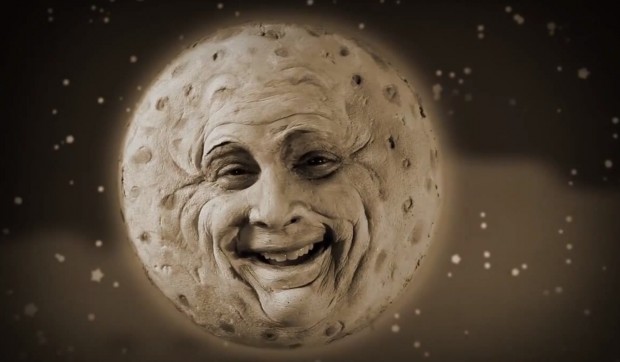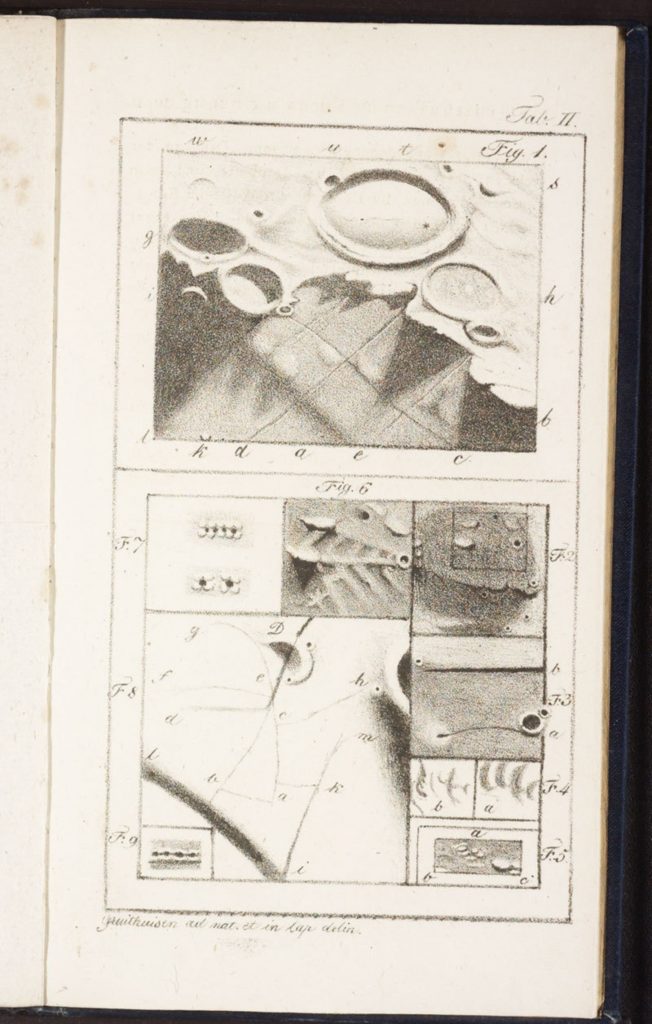More Men in the Moon June 10, 2016
Author: Beach Combing | in : Modern , trackback
Franz von Gruithuisen (obit 1854) is a bizarrist’s hero. Here is a brief summary of his published work on the inhabitants of the moon in 1824.
A few years ago, professor Gruithausen, of Munich, wrote an essay to show that there are many plain indications of inhabitants in the moon. In answer to certain questions, the Munich Gazette communicates some remarkable results, derived from a great number of observations
- In what latitude in the moon are there indications of vegetation ?
- How far are there indications of animated beings?
- Where are the greatest and plainest traces of art on the surface of the moon ?
With respect to the first question, it appears from the observations of Schroter and Gruithausen, that the vegetation on the moon’s surface extends to fifty-five south latitude, and sixty-five north latitude. Many hundred observations show, in the different colours and monthly changes, three kinds of phenomena which cannot possibly be explained, except by the process of vegetation.
To the second question it is answered, that the indications from which the existence of living beings is inferred, are found from fifty north latitude, to thirty-seven, and perhaps forty-seven, south latitude.
The answer to the third question, points out the places on the moon’s surface in which are appearances of artificial causes altering the surface. The author examines the appearances that induce him to infer that there are artificial roads in various directions; and he describes a colossal edifice, resembling our cities, on the most fertile part near the moon’s equator, standing accurately according to the four cardinal points. The main cities are in angles of forty-five degrees and ninety degrees. A building resembling what is called a star-redoubt, the professor presumes to be dedicated to religious purposes, and as they can see no stars in the daytime (their atmosphere being so pure) he thinks that they worship the stars, and consider the earth as a natural clock. His essay is accompanied by plates.
Can anyone get Beach the original, those plates of the star temple deserve to be printed… drbeachcombing At yahoo DOT com Discovery of Many Distinct Traces of Lunar Inhabitants, Especially of One of Their Colossal Buildings
For other examples of men staring through telescopes at things that are not there for years, and years and years…
First up Typhon, 30 Jun 2016: I just read your article concerning “more men on the moon”.
Sadly enough, I havent found the original yet, but it seems to be around somewhere in the internet, 79 pages A4 full of interesting stuff. Not sure if you realized it, but the Professor is actually not Gruithausen but Franz von Gruithuisen. I did manage to find some publications which seem to be the inspiration for your newspaper print (however, they are all in german): “Der bayerische Volksfreund“(page 51):
“Zweibrücker Wochenblatt” N°16, Page 61&62:
Also it is worth mentioning, that from 1822 onwards, the good professor stated that something bordering the city has disappeared but instead there are wall-like structures as used in war…
I send you a 10-Page document on the case which I found. [too big to put up, sorry!]
On page 3 you have 2 of the original pictures from Gruithuisen’s document. Starting on page 4 are the original descriptions of Gruithuisen in German. And, you will like this, on page 10 you have modern pictures of the 2 places and numbers on the old pictures with comments concerning a what is what, including the star temple.
I currently dont have the time to translate the newspaper articles or the whole document, but I will translate the comments to the numbers on page 10:
1 = Temple of the star cult, good to see on the right photo
2=Permanent-, Middle-, or Mainrange
3=Southeast-Northwest range
4=Small ringrange/ring-mountains, within which there are smoke or damp creating activities
5=small ringrange/ring-mountains, windless/calm recreation space and garden
6/7=Mountainhill in north and northwest
8=only courtyard in east with gap to northeast
9=the old city
10=small ringrange/ringmountains, incorporated into the building
11=hills in the west
Concering the places where I have put a slash, it is because I wasnt sure how to formulate it. The ringrange/ring-mountains is “Ringgebirge” in German which is what I translated or even closer “ring-mountainrange”.
Moonman, an old friend of this blog, writes 30 Jun 2016: I could not help but do so with your blog posting about the Moon, a favorite topic of mine. I am sure other readers have already answered your call, but here are some links I found with the plates: (1), (2), (3), (4) (5)

I also attach a copy from one of the sites above. I had not heard of this astronomer before. The only reason I knew where to look for the plates was that I had delved into a search of German astronomers at one time (Beer and Madler, a sort of Rogers and Hammerstein of astronomy back then) in order to see who first invented the concept of “peaks of eternal light”. Some had claimed a French astronomer Flammarion, but the Germans preceded him by decades.
Chris S, 30 Jun 2016, meanwhile points out that ‘Maybe von Gruithuisen inspired the Great Moon Hoax published eleven years later? The Great Moon Hoax refers to six, serialized articles published in The New York Sun about Sir John Herschel observing an alien civilization of bat people on the moon. Wild stuff.’
Ivo, 30 Jun 2016, writes in with a link to an archive version of the book.


